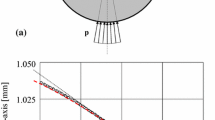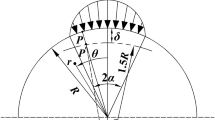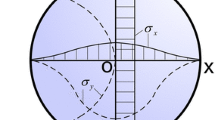Abstract
The aim of the present study was to determine the stress field developed in a Brazilian disc under conditions closely approaching those of the actual test executed according to the standardized procedure suggested by the International Society for Rock Mechanics. Advantage is taken of a recently introduced analytic solution for a mixed fundamental contact problem where the disc and the jaw are considered as a system of two interacting elastic bodies. Using the outcomes of that study, the complex potentials method is employed here for the solution of a first fundamental problem for a Brazilian disc under a parabolic load distribution. Analytic full-field formulae for the components of the stress field developed in the disc are given. The solution is then applied for the case of a disc made from Dionysos marble. The results are compared to existing ones obtained from solutions adopting statically equivalent loads either in the form of distributed (uniform or sinusoidally) radial pressure acting along the actual contact rim or in the form of diametrically acting point (line) loads. While the stress field in the major part of the disc seems to be rather insensitive to the exact load application mode, critical differences are detected in the vicinity of the loaded arc of the disc. The solution is assessed according to the results of a short series of Brazilian disc tests with PMMA specimens. The agreement between theoretical predictions and experimental data is satisfactory. Finally, it is indicated that, as opposed to previous solutions, the stress field (even at the disc’s center) is a non-linear function of the externally applied load depending, among others, indirectly on the properties of the disc’s and jaw’s materials, the combination of which dictates the extent of the contact angle.













Similar content being viewed by others
References
Hondros G (1959) The evaluation of Poisson’s ratio and the modulus of materials of a low tensile resistance by the Brazilian (indirect tensile) test with particular reference to concrete. Aust J Appl Sci 10:243–268
Hooper JA (1971) The failure of glass cylinders in diametral compression. J Mech Phys Solids 19:179–200
Jianhong Y, Wu FQ, Sun JZ (2009) Estimation of the tensile elastic modulus using Brazilian disc by applying diametrically opposed concentrated loads. Int J Rock Mech Min Sci 46:568–576
Kourkoulis SK, Exadaktylos GE, Vardoulakis I (1999) U-notched Dionysos Pentelicon marble in three point bending: The effect of nonlinearity, anisotropy and microstructure. Int J Fract 98:369–392
Kourkoulis SK, Markides ChF, Chatzistergos PE (2011) The contact length in the standardized Brazilian disc test: an analytic and experimental approach. (submitted)
Lavrov A, Vervoort A (2002) Theoretical treatment of tangential loading effects on the Brazilian test stress distribution. Int J Rock Mech Min Sci 39:275–283
Markides ChF, Pazis DN, Kourkoulis SK (2011) The Brazilian disc under non uniform distribution of radial pressure and friction (in press)
Markides ChF, Pazis DN, Kourkoulis SK (2010) Closed full-field solutions for stresses and displacements in the Brazilian disk under distributed radial load. Int J Rock Mech Min Sci 47:227–237
Muskhelishvili NI (1963) Some basic problems of the mathematical theory of elasticity. Groningen, Noordhoff
ISRM (Co-ordinator: F. Ouchterlony) (1988) Suggested methods for determining the fracture toughness of rock. Int J Rock Mech Min Sci Geomech Abstr 25:71–96
Stefanizzi S, Barla G, Kaiser PK, Graselli G (2009) Numerical modeling of standard rock mechanics laboratory tests using finite/discrete element approach. In: Diederichs M, Graselli G (eds) Proceedings of the 3rd CANUS Rock Mechanics Symposium, Toronto, May 2009, paper 4179
Vardoulakis I, Kourkoulis SK, Exadaktylos GE, Rosakis A (2002) Mechanical properties and compatibility of natural building stones of ancient monu,ents: Dionysos marble’, (in Greek). In: Varti-Mataranga M, Katsikis Y (eds) Proceedings of the Interdisciplinary Workshop “The building stone in monuments”, Athens, November 2001, IGME Publishing, pp 187–210
Wijk G (1978) Some new theoretical aspects of indirect measurements of the tensile strength of rocks. Int J Rock Mech Min Sci 15:149–160
Author information
Authors and Affiliations
Corresponding author
Appendices
Appendix I
1.1 A Note on the Complex Potential in Case of Circular Load Distribution
Consider the circular distribution:
Under the obvious simplifications: \( \ell \approx \ell^{\prime } = R{ \sin }\omega_{\text{o}} ,\tau \approx \tau^{\prime } = R{ \cos }\vartheta \) (R = R 1) becomes:
Equivalently, since \( { \cos }\vartheta = \left( {s + \overline{s} } \right)/2 \), it can be written as:
Therefore on the loaded rims (in the fictitious ζ-plane) it holds that:
Inserting the above value for \( \sigma_{\rho \rho }^{ + } \) in the general formula:
an integral appears of the form:
A closed form solution for such an integral is not available.
Appendix II
2.1 An Alternative Load Distribution
Taking the squares of both sides of the second of Eqs. (14), for R 1 = R, it follows that:
which represents the equation of a circle of radius \( \frac{\ell }{3RK} \).
A parabola (red color in the following figure) of the same area (demanded to insure static equivalence between the circular and the parabolic radial pressure distributions) that intersects the x-axis at the points \( \mp \frac{\ell }{3RK} \) is described by the equation:
See Fig. 14.
Rights and permissions
About this article
Cite this article
Markides, C.F., Kourkoulis, S.K. The Stress Field in a Standardized Brazilian Disc: The Influence of the Loading Type Acting on the Actual Contact Length. Rock Mech Rock Eng 45, 145–158 (2012). https://doi.org/10.1007/s00603-011-0201-2
Received:
Accepted:
Published:
Issue Date:
DOI: https://doi.org/10.1007/s00603-011-0201-2





